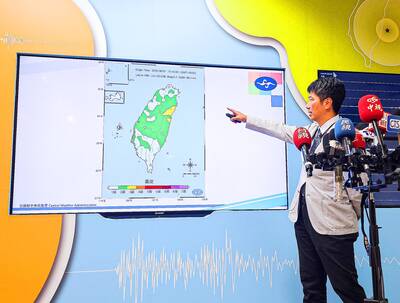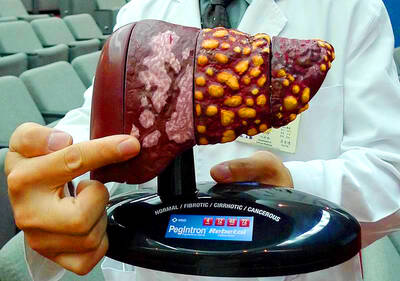When Yeh You-chin (葉有進) was a boy, he often ate migratory birds. But 50 years on, he is now at the forefront of efforts to preserve the feathered visitors to his home in southern Taiwan.
Yeh, the 59-year-old chief of Fangshan Township (枋山), recently opened an exhibition hall devoted to the brown shrike, which passes through the area every year and until recently, did so at great risk.
“I remember how the air was filled with the strong smell of roasted shrikes,” Yeh said. “Some villagers made more money catching birds than people in the cities.”
Times have changed, and conservation efforts have now moved to the forefront of most people's minds in this rural area. The exhibition hall is testimony to this development.
“Visitors to the exhibition center can learn about brown shrikes, their relationship with human beings and their plight once they are caught in traps,” Yeh said.
For centuries, residents in the south looked forward to autumn and winter, when migratory birds would fly in from northern Asia.
They called them “divine blessings” because of the delicious flavor they added to the simple rustic fare they normally put on their dinner tables.
But over the past generation the situation has changed, and the birds are now referred to as “friends from far away.”
The dozens of species of migratory birds are now seen as more useful alive than dead, because they can help boost tourism revenues.
Persistent conservation efforts have paid off as a less-dangerous environment has led to more birds visiting each year, in turn also luring more tourists to regions such as Hengchun (恆春) near the country's southern tip.
“The Hengchun area has become one of the world's top 20 spots for appreciating birds of prey,” said Tsai Yi-zung, a bird expert at Kenting National Park.
Among these is the gray-faced buzzard, better known locally as the “National Day bird” because its arrival coincides with National Day celebrations on Oct. 10.
The number of gray-faced buzzards in September and October hit a 20-year high of 49,000, the national park said.
“The public mindset has changed over the past 25 years,” Tsai said. “I can't guarantee no one here ever eats a bird, but it’s definitely a very, very small number.”
This is not just because rising standards of living meant Taiwanese no longer have to rely on wildlife for vital extra protein.
The law also plays a role, and both the rules and their implementation have become stricter, with illegal bird catchers risking jail time of up to six months.
But there is still room for improvement, said Yu Wei-daw of the Taipei-based Chinese Wild Bird Federation.
Police arrested two hunters in Hengchun in October and later found a rich haul at their homes, discovering 36 dead gray-faced buzzards.
Meanwhile, educational programs sponsored by the national park seek to make the schoolchildren more conscious of the need to protect natural heritage.
“Many of the children who have been through the programs have become adults, and they — unlike their parents — no longer eat the migratory birds,” Tsai said.

The Taipei Summer Festival is to begin tomorrow at Dadaocheng Wharf (大稻埕), featuring four themed firework shows and five live music performances throughout the month, the Taipei Department of Information and Tourism said today. The festival in the city’s Datong District (大同) is to run until Aug. 30, holding firework displays on Wednesdays and the final Saturday of the event. The first show is scheduled for tomorrow, followed by Aug. 13, 20 and 30. To celebrate the 30th anniversary of Disney Pixar's movie Toy Story, the festival has partnered with Walt Disney Co (Taiwan) to host a special themed area on

Aftershocks from a magnitude 6.2 earthquake that struck off Yilan County at 3:45pm yesterday could reach a magnitude of 5 to 5.5, the Central Weather Administration (CWA) said. Seismological Center technical officer Chiu Chun-ta (邱俊達) told a news conference that the epicenter of the temblor was more than 100km from Taiwan. Although predicted to measure between magnitude 5 and 5.5, the aftershocks would reach an intensity of 1 on Taiwan’s 7-tier scale, which gauges the actual effect of an earthquake, he said. The earthquake lasted longer in Taipei because the city is in a basin, he said. The quake’s epicenter was about 128.9km east-southeast

BE CAREFUL: The virus rarely causes severe illness or death, but newborns, older people and those with medical conditions are at risk of more severe illness As more than 7,000 cases of chikungunya fever have been reported in China’s Guangdong Province this year, including 2,892 new cases last week, the Centers for Disease Control (CDC) yesterday said it is monitoring the situation and considering raising the travel notice level, which might be announced today. The CDC issued a level 1 travel notice, or “watch,” for Guangdong Province on July 22, citing an outbreak in Foshan, a manufacturing hub in the south of the province, that was reported early last month. Between July 27 and Saturday, the province reported 2,892 new cases of chikungunya, reaching a total of 7,716

STAY VIGILANT: People should reduce the risk of chronic liver inflammation by avoiding excessive alcohol consumption, smoking and eating pickled foods, the physician said A doctor last week urged people to look for five key warning signs of acute liver failure after popular producer-turned-entertainer Shen Yu-lin (沈玉琳) was reportedly admitted to an intensive care unit for fulminant hepatitis. Fulminant hepatitis is the rapid and massive death of liver cells, impairing the organ’s detoxification, metabolic, protein synthesis and bile production functions, which if left untreated has a mortality rate as high as 80 percent, according to the Web site of Advancing Clinical Treatment of Liver Disease, an international organization focused on liver disease prevention and treatment. People with hepatitis B or C are at higher risk of